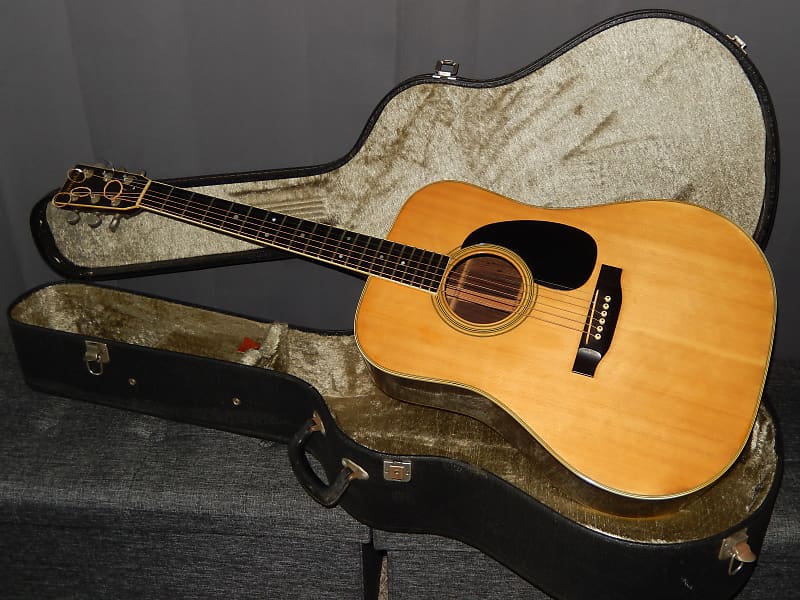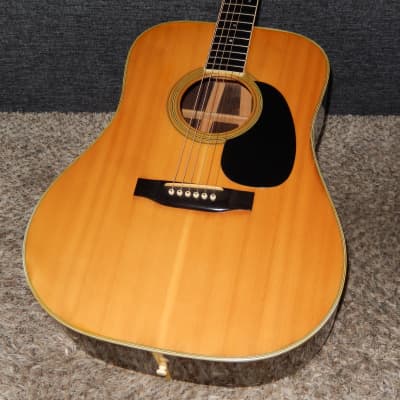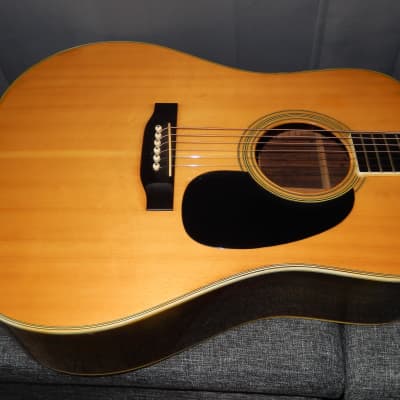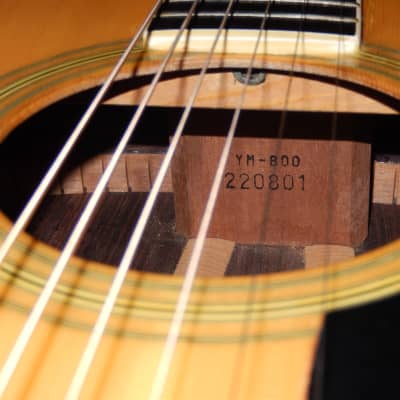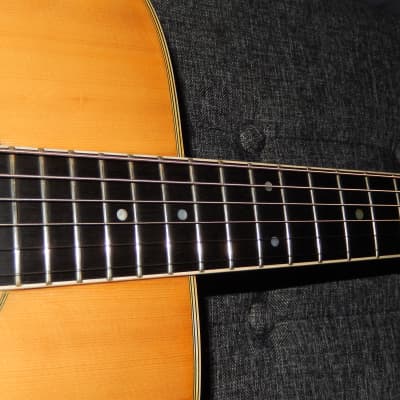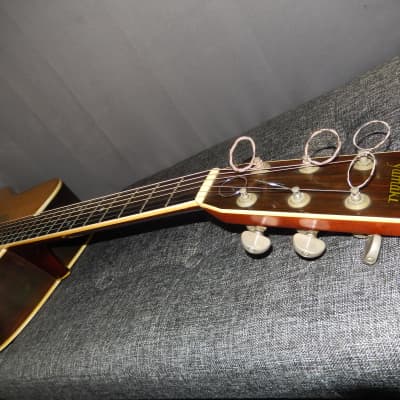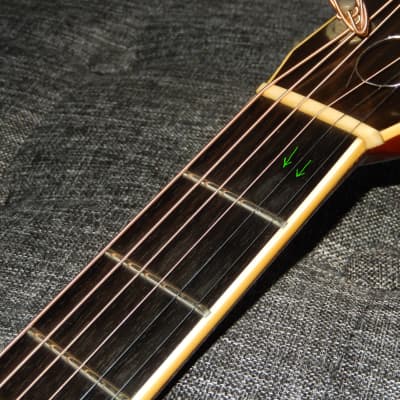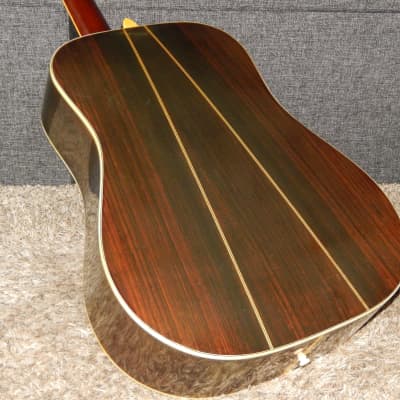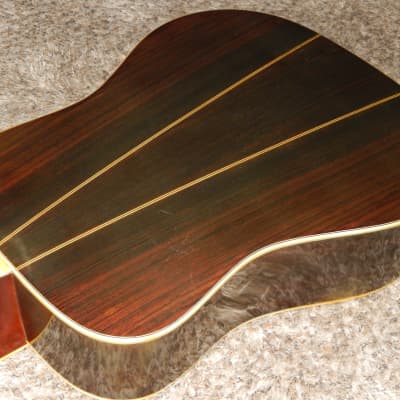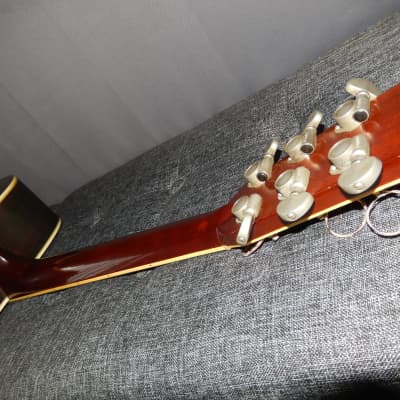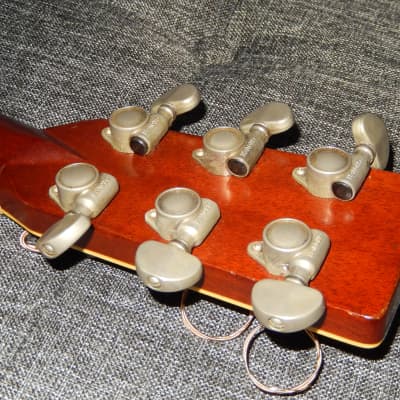Several hundred guitars I have sold in the past are presented at Facebook.com/Victors.Guitar.Library.
Yamaki YM800 1977 Acoustic Guitar
Most acoustic guitar players around the world know that since late 1960s Japanese makers were creating wonderful “copies” of Martin, Gibson and Guild guitars. Many experienced players know that many of these “copies” sound better than the “originals”.
During 1970s Yamaki was of one of leading Japanese Gakkis, making high grade classical and based on Martin blueprints terrific steel string acoustic guitars. Greatness of Yamaki acoustics has been recognized all around the world and their value remains unquestioned. Many experienced players know that they sound no different from “made in USA” originals. Some say, that they sound better.
This very fine guitar was made around 1977 being a midrange model within Yamaki’s YM series, bettered by models YM1000, YM1200, YM1500 and YM2000.
If you are familiar with far more expensive Martin guitars, there is a great chance, that you’ll be very happy with this amazing Yamaki instrument.
This guitar sounds simply fantastic. It offers very impressive volume, super response and very rich, sparkly, yet sweet and lyrical tonality, with plenty of overtones and harmonics. It certainly deserves a title of Grand Orchestra instrument. With its current action it plays super easy.
This guitar was priced 80 000 yen in 1977, being relatively expensive instrument on Japanese market. Decent beginner’s grade guitars were available for no more than 10 000yen.
While overall condition of this guitar can be described as “very good for its age” it comes with few imperfections. There are few tiny dents and small scratches on its top, few very light scratches on its back. While it is attached very firmly, the section of the pickguard has air trapped underneath, hence flexes if pressed on. There is some wear on the fingerboard (with 2 groves near 1st fret and second string being the deepest). (You are right assuming that) none of these imperfections affect sound or playability of this guitar.
Practically all Yamaki guitars from 1970s have developed serious cloudiness within finishes, especially on their headstocks. On this guitar this cloudiness is relatively mild and greatly exaggerated on the pictures. Although have lost their original luster, original tuning keys work fine.
Most importantly it doesn't have any structural flaws, its frets are in great shape, while its vintage sound surpasses sound of many brand new perfect looking guitars sold in USA for $5000+.
Specification:
Top: Solid Spruce with reinforcing ring of wood glued underneath the sound-hole /Martin style X bracing with not scalloped braces /lacquer
Back & Sides: Solid Rosewood/lacquer
Neck: Mahogany with 2-way truss rod
Fingerboard: Ebony
Nut width: 43mm
Scale: 640 mm
The action is set to 2.50 mm under E6 and 2.00 mm under E1, with plenty of extra room on the saddle.
My posted for sale guitars are stored in climate-controlled vault already packed into shipping boxes, with loosen strings. Because the strings are loosened, they don’t pull the neck or soundboard, and the neck may relax (straighten more) and the soundboard flatten a bit, which may result with the string action being lower than my it was with my original settings and lead to buzzes and/or dead notes after guitar arrives to you. Such a change in neck curvature can also happen just because of vibrations during the shipment and/or temperature fluctuations. Therefore, you must be ready to make final action adjustment yourself and or have it done by professional. All that really needs to be done is the simple neck adjustment by using the truss rod (turning the truss rod counterclockwise will relief the neck and strings will move away from the frets).
THAT IS WHY TRUSS RODS ARE INSTALLED IN THE NECKS OF ACOUSTIC GUITARS!!!
This guitar will be shipped in used hard shell case in very good condition.
Yamaki Story as published by jedistar...
The story of Daion and Yamaki guitars is entwined with the histories of a number of other Japanese companies.
In the late 1940s, brothers Yasuyuki and Kazuyuki Teradaira started working for Tatsuno Mokko, an instrument-building firm that later split into two different companies, one of which was called Hayashi Gakki. In 1954 Hayashi Gakki was bought out by , a large music distributor. In 1962 Yasuyuki left Zenon to start an instrument distributor he called Daion, located in Osaka and Daion is the Wholesaler of the Musical Instruments, and Daion distributed guitars exclusively throughout Japan. Daion means “big sound” in Japanese.
In 1967 Kazuyuki left Zenon to produce classical guitars under the name located in Suwa City, Nagano Pref., an auspicious Japanese word meaning “happy trees on the mountain.
By the early 1970s, Kazuyuki expanded the Yamaki line to include a large number of steel-string guitars, many of which were based on C.F. Martin and Co.’s designs and were distributed exclusively through Daion. Along with Yamaki guitars, Daion sold instruments from Shinano, Mitsuru Tamura, Chaki, and Hamox, some of which were built by Yamaki at various times, and guitars, which they imported from the US.
Before Mr. Hirotsugu Teradaira joined the organization, Yamaki was the guitar brand and Daion is only the wholesaling company’s name, and it was not the name of the guitar brand. Yamaki factory produced the acoustic guitars and Daion distributed Yamaki guitars exclusively in Japan.
But Teradaira Brothers market was only restricted to Japan when they started. Sometime in the late 1960s, Daion began exporting Yamaki guitars to America and Canada, where they were well received.
Yamaki’s production capacity was around 1000 instruments pr month – or around 33000 in total. Out of the 1000pcs. production capacity per month some were under Yamaki name and also Washburn USA brand and finally the Daion name. These were roughly split into Daion 70%, Yamaki 20%, Washburn 10% (Wings, Stage, and acoustics).
After Mr. Hirotsugu Teradaira graduated from the University in 1974, he joined his father’s distribution company. Daion Ltd in Osaka. Overall there were a total of 30 people working there. The Yamaki factory was located in Suwa and there were overall only about 50 people at the factory.
In 1975 Mr. Hirotsugu Teradaira negotiate with one of the biggest wholesaling company in Canada, who were already handling Yamaki guitars. Their name is Great West Imports Ltd., and their head office is located in Vancouver. As a part of that deal, The Great West Import company hired Mr. Hirotsugu Teradaira as a warehouse worker doing the daytim and he studied English at the Community Collage after hours. This lasted for good 2 year until 1977.
After those 2 years Mr. Hirotsugu Teradaira came back to Japan and he started to designing acoustic guitars under the series name of The Year Series. This was in from 1978. After he had introduced The 78 Acoustic guitar he also started to add significant difference on each Year series and each electric guitars.
Later he also designed several other Daion instruments including the Daion Headhunter as well as Yamaki and Washburn instruments.
There are 3 dates on the different Yamaki/Daion instruments. 1954, 1962, 1967.
1962 dates to when Yamaki was founded.
1967 was when Daion was founded.
That leaves 1954. This date is very interesting because there is a lot of history there. Adding an older image to the Daion brand, after talking to his uncle, Mr. Hirotsugu Teradaira decided to use 1954 as this was the first year that his uncle made his own guitar as a luthier.
Besides Canada, Mr. Hirotsugu Teradaira appointed one distributor in one country so there were the exclusive distributors in UK, France, Norway (incl. Sweden, Denmark), Finland,Italy, Switzerland, Greece, Australia, Singapore.
By the early 1980s, however, Daion felt that the Yamaki Martin-style guitars were getting lost among similar instruments from other Japanese builders like Takamine, Yasuma, and C.F. Mountain, so they redesigned the entire acoustic line and started building acoustic-electrics and solid-body electrics as well as oddities like double-neck acoustics. They dropped the Yamaki name and rebranded their instruments as Daion guitars. Daion began an extensive advertising campaign to introduce the new line around 1982, but this was a time when musicians were more interested in the new MIDI-equipped synthesizers than in
guitars.
In 1983 Yamaki moved from Suwa to Shiga, but both place are in Nagano Pref. and in fact, those 2 places are not too far away apart.
In 1984 Yamaki/Daion stopped exporting guitars to America and went out of business. At the time of bankruptcy, it was nothing but chaos.
After the bankruptcy of Yamaki/Daion, Teradaira brothers split and their correspondences came down to almost zero.
After Yamaki/Daion, Mr. Kazuyuki Teradaira moved and start producing Persimmon Wooden golf club heads. He was quite successful making those.
Any Daion instruments you see after mid 1984 were made by unknown luthiers. No Yamaki people produced any instruments around mid-80’s.
The key to understand value of vintage Japanese guitars is to acknowledge galloping price inflation (devaluation of Japanese yen) during 1960s & 1970s. This inflation slowed down in 1980s.
During 1960s and most of 1970s model numbers of Japanese guitars were strictly interconnected with their prices in Japanese yen. By early 1980s and during following decades model numbers were no longer strictly associated with their prices. Some Japanese guitar makers introduced model names instead of model numbers. Others were still using model numbers with addition of letters and/or other symbols.
It is then important to understand that two Yamaha GC10 guitars made 10 years apart are two instruments of totally different class. The same applies to any other Japanese maker/brand.
The best way to estimate the true class of any given Japanese made instrument is to compare its price with the average annual salary of wage workers in Japanese private sectors. This salary was 450 600 yen in 1965; 825 900 yen in 1970; 1 868 300 yen in 1975; 2 689 000 yen in 1980; 3 163 000 yen in 1985; 3 761 000 yen in 1990; 4 107 000 yen in 1995; 4 082 000 yen in 2000.
Any guitar priced 100 000 yen in 1970 (labelled usually as No10) would be priced 200 000 yen in 1975 (relabeled to No20 or 2000), 300 000 yen in 1977 (labelled as No3, No30 or 3000) and 500 000 yen by 1985 (labelled as No50 or 5000).
Starting in 1977 Masaru Kohno introduced his new models No40 priced 400 000 yen and No50 priced 500 000 yen. By 1984 Kohno started using model names instead numbers and was raising their prices as he was pleased. The very top model 50 became model “Special”, and a decade later it became model “Maestro”. Naturally, all other Japanese guitar makers were doing similar pricing (labelling) upgrades.
Knowing all of that, you can bet on that Masaru Kohno No50 made in 1982 is practically the same grade instrument as Kohno No20 made in 1972, or Kohno no 30 made in 1975.
In early 1970s the lowest Ryoji Matsuoka (all plywood) model was 10, followed by (solid top) models 15, 20, 25, 30, 40, 50, 60, 80 and (all solid woods) models 100 and 150. Models 50, 60 and 80 were made with non-solid figured Brazilian Rosewood (double) back and sides and top model 150 was the only one made with solid figured Brazilian Rosewood b/s.
In 1980 the lowest Matsuoka model was (all plywood) 20, followed by (solid top) models 30,40,50, 60 and all solid woods models 80,100,150 and 200. By 1990 the lowest Matsuoka model was M40 and the highest was M300. By 2010 the lowest Matsuoka model was M50 and the top model was M270.
You can bet that Ryoji Matsuoka model 50 from 1980 is of the same grade as model M100 from 2000, model 100 from 1980 is of the same grade as model M150 from 2000, model 150 from 1980 is of the same grade as M200 from 2000 and model 200 from 1980 is of the same grade as model M300 from 2000.
It is important to mention that if modern era luthiers are using 40+ years old woods to make an “all solid” wood classical guitar, its price is minimum $8000.
All vintage guitars made with Brazilian Rosewood are especially precious, including those made straight grain varieties and those with non-solid b/s.
Because response and tonal properties of Spruce soundboards are improving over time, long seasoned Spruces are far more precious than long seasoned Cedars.
It is not very difficult to find out what are current prices of such guitars made by world’s leading luthiers.
